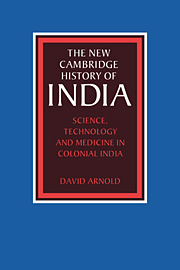Book contents
- Frontmatter
- 1 Introduction: science, colonialism and modernity
- 2 Science under the company
- 3 Western medicine in an Indian environment
- 4 Technologies of the steam age
- 5 Imperial science and the Indian scientific community
- 6 Science, state and nation
- Conclusion
- Biographical notes
- Bibliographical essay
- Index
- THE NEW CAMBRIDGE HISTORY OF INDIA
- References
4 - Technologies of the steam age
Published online by Cambridge University Press: 28 March 2008
- Frontmatter
- 1 Introduction: science, colonialism and modernity
- 2 Science under the company
- 3 Western medicine in an Indian environment
- 4 Technologies of the steam age
- 5 Imperial science and the Indian scientific community
- 6 Science, state and nation
- Conclusion
- Biographical notes
- Bibliographical essay
- Index
- THE NEW CAMBRIDGE HISTORY OF INDIA
- References
Summary
It is a well-established convention to see the nineteenth century as an age of innovative steam technologies, developed first in Europe, then diffused to other regions of the globe. In an era characterised in terms of ‘a massive transfer of technology from the West to Africa and Asia’, and with colonialism as a convenient conduit, India has often been taken to exemplify the momentous scale and impact of this process. But although the transfer of technology argument duly highlights the importance of exogenous innovation and the role of technology as a ‘tool of empire’, it can easily become an excessively one dimensional idea, stressing the dynamism of the West but ignoring the context in which new technologies were employed. Technologies are seldom discrete bodies of knowledge, transferable wholesale, without emendation, from one society to another. Technological transfers are more likely to take the form of a ‘dialogue’ rather than a simple process of diffusion or imposition, and this was especially the case in India, which had a wide range of existing technologies and a physical and social environment far removed from that of Europe. Equally, it needs to be recognised that under colonialism the dissemination of new technologies was constrained and conditioned by the partisan nature of political and economic control. Colonial rule interrupted the ‘inventive exchanges’ India had formerly had with its Asian and Indian Ocean neighbours and created instead a near-monopoly of technological dialogue with and through the West, and, primarily, with Britain itself. State power was used to promote technologies that served the regime’s military, economic or ideological needs while restricting Indian access to technologies that might harm metropolitan interests.
- Type
- Chapter
- Information
- Science, Technology and Medicine in Colonial India , pp. 92 - 128Publisher: Cambridge University PressPrint publication year: 2000
References
- 2
- Cited by

